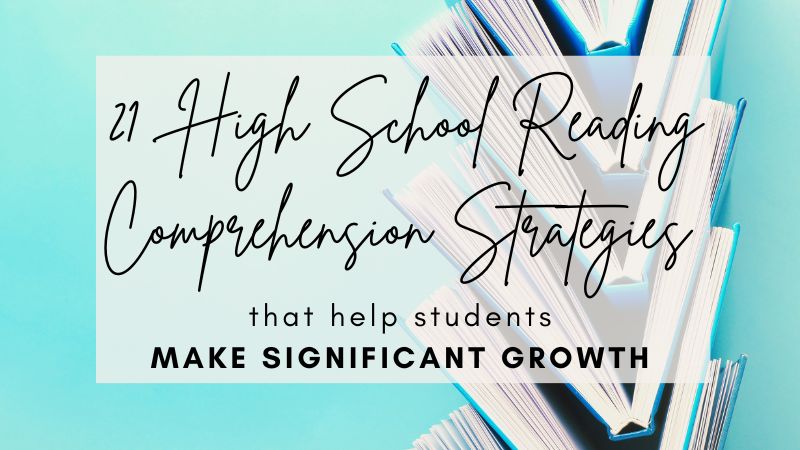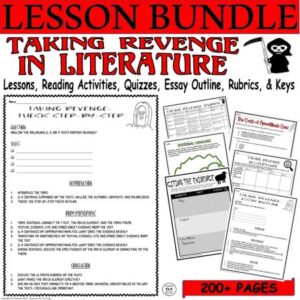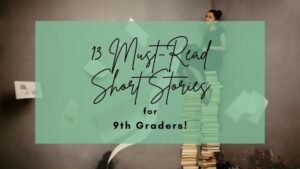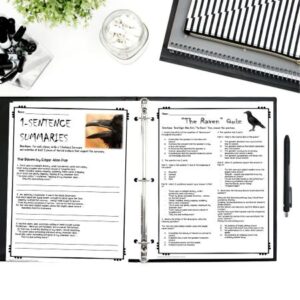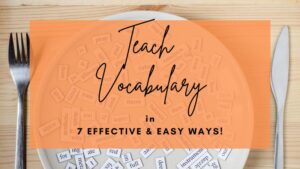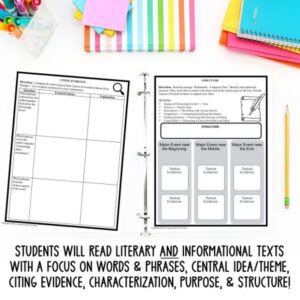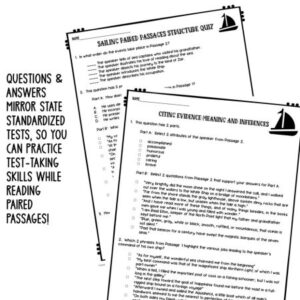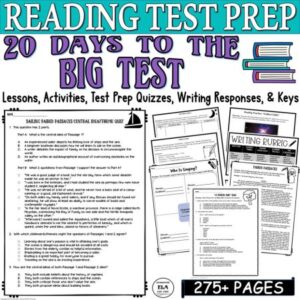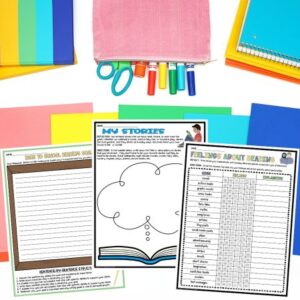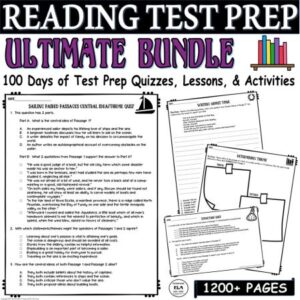If you have ever been a high school reading and comprehension teacher or an English teacher, you will know the struggle of teaching reading skills, standards, and texts to students. I know it might seem simple on the surface, but teachers nowadays have students who actively DON’T want to learn, have difficulty paying attention, cannot sit still, may not understand how to act in an educational environment, will not adhere to any sense of accountability or responsibility, etc.
When I started teaching in 2005, lesson planning was the least of my worries. The process of teaching, however, involves more than knowing major pedagogical concepts. Most of my first five or so years of teaching were spent developing classroom management strategies, so I could actually instruct my students in something valuable like reading and comprehension.
Overall, I believe teacher education programs are a bust. They require you to spend VERY little time in actual classrooms and set up most new teachers for failure.
Time and experience, however, are the BEST teachers. And because an English teacher’s job involves more than simply lecturing on Shakespeare’s Romeo and Juliet or reading Romantic poetry to engaged students, let me give you some real-life tips no one in higher education will tell you when it comes to teaching reading and comprehension!
Keep reading for 21 High School Reading and Comprehension Strategies That Help Make Significant Growth!
Need help with reading and comprehension Test Prep? Check out this FREE Pack of 3 Test Prep Activities to help students achieve success on standardized tests!

21 High School Reading and Comprehension Strategies That Help Make Significant Growth
1. Read a lot with your students.
I was never told by my English Education professors that 1) my students might not like the process of reading and comprehension 2) my students would usually be way behind grade level 3) my students may think they are naturally bad readers.
These ideas were quite foreign to me as I was an avid reader growing up. I would argue that my parents taught me to read, not my school teachers. By kindergarten, I was reading small picture books, by 4th grade Nancy Drew was my best friend, and by middle school, I had emotionally and mentally joined the Babysitters Club!
Why don’t many of our students like to read, especially those in high school? I am firmly convinced it is because they don’t read enough. When something is difficult, we tend to avoid it. When we are good at something, even if it’s not our favorite activity, we don’t run away from it!
Now, when I say “read a lot,” I don’t mean that you should just read whatever text is assigned for the day with your students. I actually mean read lots and lots and lots. One short text per day or several pages from a novel is, most of the time, simply not enough to help students improve in reading and comprehension.
There is a HUGE reason an educational gap exists, and usually, it is linked to exposure to educationally related concepts. For example, if Student A at the start of kindergarten has read 30 minutes with his/her family every day since the age of 2, we are talking about over 700 hours of reading brought into the classroom. And if Student B has maybe only read 30 minutes a week with his/her family, then he/she has only read about 100 hours.
The difference is staggering. How can Student B possibly “catch up” to another reader? Well, we as teachers must meet our students where they are, so the real goal is to make gains or progress and try to catch up, not to other readers but to the reading and comprehension grade level.
Spending most of your time reading with students will greatly help with reading and comprehending!
2. Read varied texts.
If you are anything like me, you love literature. That may be why you became a teacher. You fell in love with the poems of Langston Hughes, the short stories by Edgar Allan Poe, or novels by Jane Austen. Many of our students, however, will not read a poem beyond 12th-grade British Literature. They will not read a short story unless someone reads it on social media. They will not read Austen unless they see a quote on a T-shirt about Mr. Darcy.
It’s unfortunate, but true.
So having a good mix of texts to engage students is vital for growth in reading and comprehension. Don’t avoid a poetry unit even if it is tough. Likewise, don’t just read young adult novels because they are initially appealing to your students. Like spices we include in our cooking, we need varied texts, including supposedly “boring” articles!
Nonfiction literature like news articles, podcasts, and online videos provide amazing opportunities to expand our students’ reading levels!
You might think that they can always “read” these types of texts on their own, but let’s face it; they won’t!
Hey, maybe by exposing students to new genres, topics, or formats, they will find something about reading and comprehension to enjoy!
Check out this thematic unit bundle with a focus on test prep, writing, and literary analysis!
3. Have multiple readings within your instruction.
My hubby, an intensive reading and comprehension teacher at a school where only 20% of students are at grade level, reads A LOT with his students. He even admits that he would assign more independent reading in the past that he now embeds into his direct reading instruction.
He does something I admire and use in my own classroom! He reads a text multiple times in varied ways.
MULTIPLE READING IDEAS-
- Read aloud at first without stopping. Hearing texts read out loud can be helpful for anyone in their reading journey!
- Read while modeling how to annotate for a purpose. You can connect the annotations to determining the central idea, making inferences, identifying vocabulary, etc.
- Read and question. Good readers have questions about what they have read, so having students create questions along the way helps engage the most reluctant readers!
- Read and respond to teacher questions. Because our students have to take standardized tests every year, they need to see higher-level questions and practice responding to them!
Think about it. If you only read a paragraph or two with your students and “require” them to read the rest, you can never truly be sure they have read all of the text. Sure, they could zone out as you read aloud, but that would undoubtedly happen anyway if you assign most of the reading to them.
Instead, their reading and comprehension time can be spent productively by including many readings of the same text!
Check out the post below for Must-Read 9th-grade Short Stories!
4. Move students around for optimal learning.
This strategy for reading and comprehending involves a bit of classroom management. Students don’t have a right to sit wherever they want. They might think so, but they don’t. They need to sit where they will learn the most!
So move students around until it makes sense for them and you. For example, if you have a student who regularly falls asleep, you might want to group him/her with a bunch of talkers. It’s hard to sleep if people keep talking near you!
And I know. I know. Students may have IEPs with preferential seating as an accommodation; however, if a student is causing havoc or not progressing in their reading and comprehension skills, then you should be able to work with parents/guardians to relocate that student, so he or she can grow the most. It DOES NOT mean that a student’s will reigns supreme, and if someone tells you otherwise, it is not true.
5. Have fun when you can.
The definition of “fun” is relative when it comes to teaching reading and comprehension. So, I try to have fun while I teach and that looks different for different types of teachers.
I am a natural extrovert, so when I read aloud, I change my pitch, read with different voices, alter my volume, and even crack a joke or two about the text. I teach higher-level, more classic texts with a “fun” spin, and my energy is steadily high all day.
In contrast, my husband is a pretty extreme introvert. Teaching 35-40 10th graders every day can be quite taxing, so he knows he must purposefully increase his energy a bit while teaching. He tries to choose more “fun” texts and offer “controversial” opinions while reading. He loves chatting about informational texts, and he attempts to make the text connect to students in some relevant way.
We all have fun in various ways while teaching reading and comprehension, and all of us can reach our students in a mode that matches our personalities!
6. Start small with excerpts of a passage when focusing on skills.
To practice reading and comprehension skills, you don’t have to read epic poems, thousand-page novels, or an entire encyclopedia. You can start small!
Let’s say you have read aloud an entire short story like Ray Bradbury’s “The Veldt.” Before you ask students to identify the central idea or theme of the whole story, you might focus on examining the first sentence. Students can look at the subject of the sentence, choose words or phrases to analyze, and then write about the gist of the sentence in a 1-sentence summary!
The purpose of starting small is to build stamina. If you read a poem like Edgar Allan Poe’s “The Raven,” you might just ask students to summarize 1-2 stanzas versus the WHOLE poem!
Likewise, instead of reading the entirety of Romeo and Juliet, you could have students read certain passages like Act 1, Scene 5 (the party) or Act 2, Scene 2 (the balcony scene). Don’t make it too easy and read NONE of the play, but help students become more resilient by reading/examining larger and larger passages!
7. Match struggling students with mentor students.
If you are challenging your whole class with higher-level reading and comprehension texts, you will ultimately meet the needs of your students who read at or above grade level.
To help struggling readers grow in their reading and comprehension skills, you might try pairing them up with mentor students. Please, don’t think that this has to be official or even explained to students in a particular way. Instead, you can just mention that this pairing will be beneficial for both kiddos!
WAYS TO MATCH STUDENTS FOR GROWTH IN READING AND COMPREHENSION:
- Higher-Level Readers/Lower-Level Readers
- Mid-Level Readers/Lower-Level Readers
- Super-motivated readers (of any level)
- Personality Synching Readers
- Friends who challenge each other
I once paired up a low-level reading student with a student who earned a 4 on the AP Lang test. At the end of the year, the struggling student achieved one of the highest scores on the retake! Plus, these students became friends as they had spent the past year with each other!
8. Teach vocabulary.
While I am not a huge fan of spelling or vocabulary tests, I do love teaching both subjects! Students can learn vocabulary through explicit instruction, natural conversations, listening in various forms, or by reading!
Most of my personal vocabulary comes from everyday life and reading, NOT from lists of words to memorize.
HERE ARE ACTIVITIES TO TEACH VOCABULARY THAT ARE EASY TO IMPLEMENT:
- Teach Roots, Suffixes, Affixes, and Prefixes through what you are reading. For example, we want to see the roots you are studying in action whether in a quote, poem, paragraph, or short story!
- Teach how to use Context Clues. While it might be natural for some students, others need explicit instruction in the skill of utilizing context clues. Try finding a more complex word while reading and model how to find clues.
- Teach the Focus Text’s Vocabulary. As you read, stop at more difficult words, provide a basic definition, and move on. Super simple. I do this with my own children pretty much every day!
- Teach Antonyms & Synonyms. I love knowing multiple words for similar concepts and stopping to provide a synonym or antonym will provide a more in-depth reading experience for your students.
Learning vocabulary takes time, and there is no quick trick to increasing one’s vocabulary.
If you need more ideas for teaching vocabulary, click below!
9. Read aloud every day.
This strategy for reading and comprehension may seem very simple and repetitive, but trust me, reading aloud is probably the most powerful way for your students to learn fluency, vocabulary, syntax, and overall comprehension.
Don’t feel, however, that you have to do ALL of the reading. Audiobooks, online videos, digital plays, etc. can help save your voice when it is tired and hoarse!
10. Stay focused on the text for EVERYTHING.
We live in a world rife with people who have opinions. And that is fine. You have the freedom to believe or say anything.
When it comes to critical thinking, reading and comprehension, however, we need our students to see value in evidence. Having support for your ideas rather than mere opinion is the goal.
Picking answers out of thin air is useless; knowing the answer is key. And it all starts by going back to the text for EVERYTHING!
Evidence is key! I always tell my students to go back to the text. This strategy has been a game-changer when it comes to reading and comprehension!
11. Encourage students to chat with Talk and Turn.
Not every discussion has to be a formal whole group chat or Socratic Seminar. Why not have students simply talk with a neighbor?
When students talk about what they have read, they are automatically more engaged, even if they don’t love every minute of the reading. The chat doesn’t have to be long just focused on the text!
Make sure to time it or a quick Talk and Turn could easily become a waste of time…
12. Guide students in what good reading looks like.
Good readers do certain things without realizing it. When I check out a book, I look over the cover, read the title, check out the summary on the back, etc.
As I begin reading the first several pages, I make sure that I am following along with major information like the setting, the characters, and the introductory details.
Sometimes, I reread as I move through a book, not because I am a bad reader, but because I am a good reader! I may also search for an unfamiliar word’s definition or concept and perhaps research the author, so I can more fully comprehend his/her perspectives.
Students need to see this process played out. Additionally, thinking aloud may help the most in displaying this reading and comprehension skill!
13. Model how to question the text.
We as a society don’t question what we are told nearly enough. Too often, we learn something new and it stops there. We never really question what we read or hear.
AND WE SHOULD!
Before, during, and after reading a text, we need to model how to question effectively for our students.
Here are some examples for your reading and comprehension questions:
BEFORE READING-
- What is the title?
- What might the title signify?
- What is the topic?
- What images might help me with reading this text?
- Why is my teacher making me read this?
DURING READING-
- What is this paragraph saying?
- What is the meaning of this word?
- Why does this sentence sound odd?
- What ideas are repeated as I read?
- How is the text organized?
- Who are the main characters?
- How do the characters change?
- What lesson am I supposed to be learning?
AFTER READING-
- Do I understand what I read?
- What words do I need to look up so I can understand certain parts better?
- What paragraphs were confusing?
- What were the most interesting parts of the text?
- What message was the author trying to relay?
Want to make your life a bit easier as you prepare your students for standardized tests? Click HERE!
By constantly questioning, we are showing our students not only how to be good readers but also how to be good citizens who don’t accept whatever we are told! Reading and comprehension require more than sitting and getting!
14. Watch your students.
I wish students would line up to read or stare at us enraptured; however, they usually don’t. Sometimes, our clues to real student engagement come opening up our eyes once in a while.
Are they participating?
Do they look interested?
Are they reading along and turning the pages?
Do they seem to need a break from paragraph to paragraph or page to page?
If you see MOST of your students have their heads hanging low, it’s time to try something new! A new technique, a quick video about the topic, a brain break, a during-reading question, a game that encourages kids to know where you are if you stop reading…the sky’s the limit!
15. Scaffold reading and comprehension activities.
Ultimately, our students are given a standardized test at least once, if not many times during the year, through formative, benchmark, or end-of-the-year reading tests. Most states require some type of reading comprehension exam. The exam often contains 50-60+ questions with 5-6 passages, short responses, various types of questions, etc. all within a timed environment.
So we have to help our students develop the mental, physical, and even emotional muscles to stay focused even when they would rather quit and put their heads down!
These are some reading and comprehension strategies that work for me:
- Start with smaller texts (short articles, poems, songs, etc.) and build up to analyzing/reading 3 or 4 longer passages by around February.
- Embed test prep questions/answers throughout the year as you teach short stories, poetry, and nonfiction instead of just practicing 2 weeks before the big test.
- Model test-taking skills like underlining, annotating, 1-sentence summaries, skimming, going back to the text, etc. for EVERY text you read, starting in August!
- Use higher-level literature MOST of the time in your instruction, even if your students are lower-level readers. The test is NOT going to be easier for them.
- Begin with paragraph responses and build up to 4-5 paragraph essays.
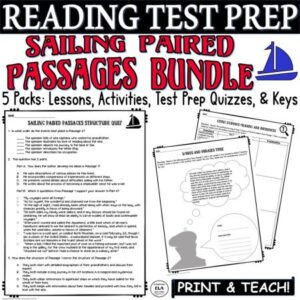
16. Insist on complete sentences for writing responses.
When students write, they remember, but unfortunately, they don’t write nearly enough or completely enough in the world outside of education.
If we want our students to progress in reading and comprehension, we need to ask them to respond to literature, both fiction and nonfiction, in complete sentences. Without complete sentences, we are missing complete ideas. Offering a few mentor sentences may help in this process.
PRO-TIP: When students read their own writing aloud, they usually can hear what is incorrect in terms of flow, diction, and grammar. Or your students could pair up and trade their writing; having another student read aloud their words will definitely get their attention. If another person can barely read and understand what you have written, then it is time to get to work revising your writing!
17. Practice test-taking skills.
We all need to practice test-taking skills in reading and comprehension situations because a “TEST” can be unnerving for just about anyone! Our students are no different. If we send them into the testing rooms without preparation, it may become overwhelming.
Here are my go-to test-taking skills:
- Answer every reading and comprehension question; usually, there is no penalty.
- Read as much of the passage as you can; skimming usually only works for higher-level readers.
- Use highlighting and annotation (short notes) in connection to the topic.
- Skip a more difficult passage and come back later.
- Work until the very end or at least with only minutes to go.
- Check all answers to make sure you have a response for each question.
- Practice with technology ahead of time, whatever that looks like for your school.
Want ready-made test prep activities with questions and answers that mirror standardized tests? Click below!
18. Conference with students throughout the year.
Student-teacher conferences don’t have to be long to yield great results. Students need to know where they are in their reading and comprehension abilities, so they can work on areas to improve. A 2-3 minute conference every quarter or even semester might be just the ticket!
You can discuss past scores, current grades, and future aspirations! Right before the state test in reading and comprehension is a great time for a conference, especially if you use the time to encourage each student to do his or her best!
19. Set reading goals.
My hubby has been a teacher for 6 years; he has primarily taught intensive reading to the most struggling students at his school. One of the things he would ALWAYS have his students do is set reading goals, especially at the start of the year. And it has worked!
His students’ gains in reading and comprehension have been ASTOUNDING!
Looking at where you are and where you want to be is VITAL! Setting goals for reading and comprehension is a must for high school students!
20. Offer extra credit through educational games.
My students will do practically anything to get extra credit, but random extra credit is not my thing. My goal, as always, is to help my students grow. Extra credit comes in the form of accomplishing certain goals, especially goals linked to reading and comprehension.
You can assign online articles and questions through various sites, let students use https://www.wordhippo.com/ to complete vocabulary activities or redo certain assignments.
Don’t give students free rein though. Make sure that students submit valuable reading and comprehension work in a specific time period. Waiting until the last day of the quarter is a no-go!
21. Require more, not less.
Reading and comprehension growth cannot happen if we ask less of our students. I am NOT saying students need more homework or to read 10 novels every year outside of class. In fact, as a mom of 4 kids, I am NOT a fan of homework as a rule.
I AM saying that there is WAY too much downtime in most classes. Think about how much time is wasted as you try to get the non-workers to work, the sleepers to wake up, and the talkers to stop talking. And don’t get me started on pep rally days, class pictures, random class surveys, and testing! That is why we MUST use our time wisely.
Yes, students have weaknesses in certain areas; we all do. But making a text easier through rewording websites, asking for only paragraph writing when students will have to write a full essay on the state test, or only ever reading one-page texts will not make our students’ lives any easier.
Even the most struggling student has the right to a high-quality education. If we only based our instruction on students’ reading or writing levels from standardized tests or a survey from the beginning of the year, we are doing our students a disservice.
They deserve to have the opportunity to go to college, enroll in higher-level learning, and pursue their educational goals; however, they will not be able to accomplish any of their dreams if we make everything easier for them.
Easier is not better, especially when it comes to reading and comprehension. Easier will not get our students where they want to go.
READING TEST PREP RESOURCE:
This High School Reading Comprehension Passages and Questions Test Prep Lesson ULTIMATE BUNDLE prepares upper middle and high school students for state exams and assessments (with informational texts, literary texts, and paired passages).
It includes 100 EASY-TO-TEACH Reading Test Prep Lessons with Worksheets, Activities, Writing Responses, Passages, and Common Core Style Test Prep QUESTIONS and ANSWERS that integrate test prep into the teaching of literature!
Want reading and comprehension activities for your high school students? Check out my store, Kristin Menke-Integrated ELA Test Prep!

